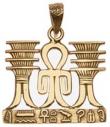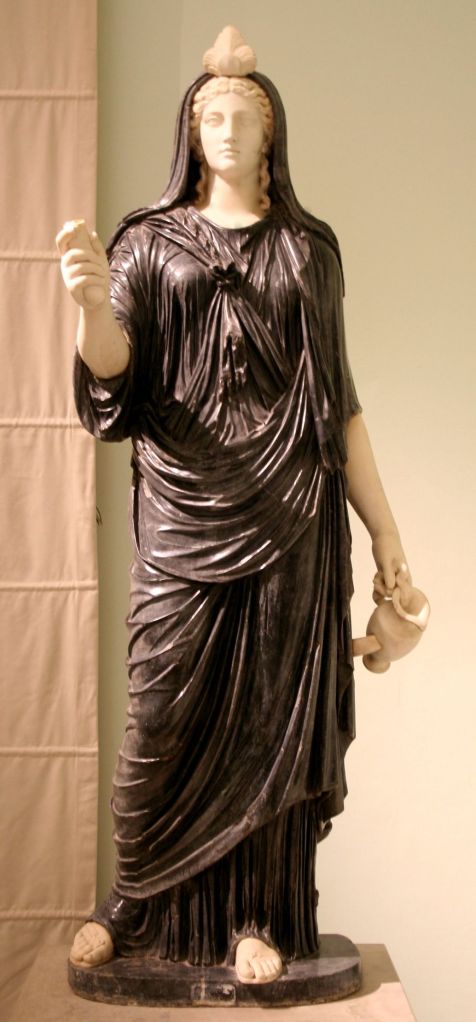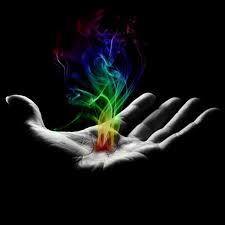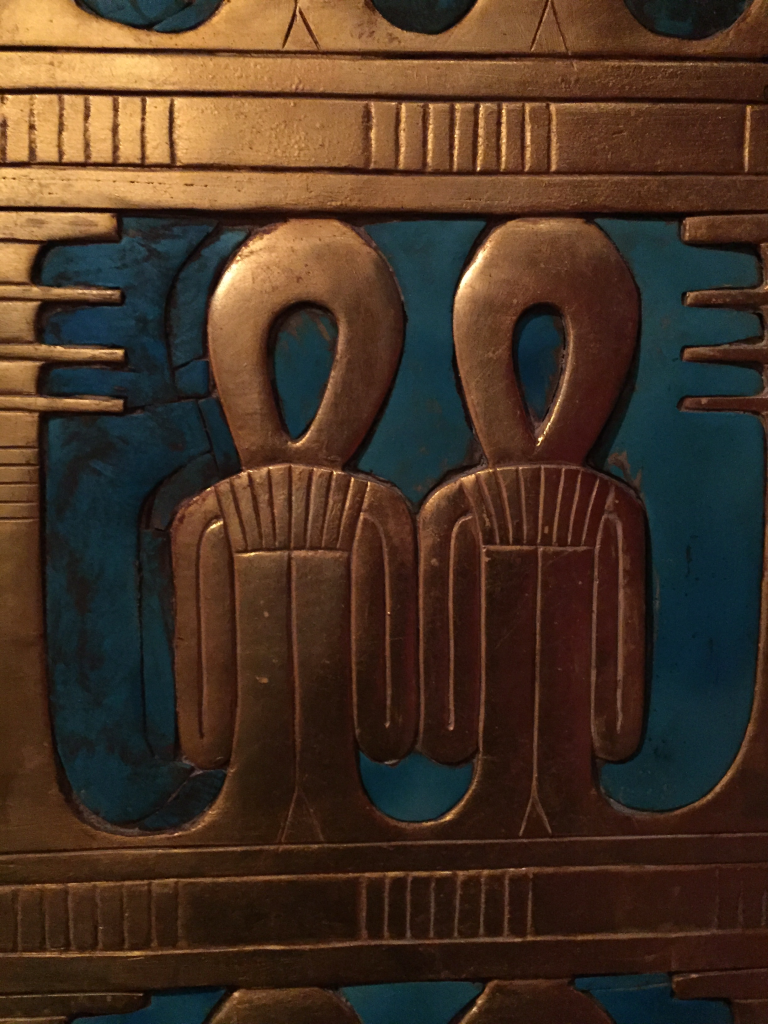
The image to the left is the standard form of the amulet known as the tyet or Knot of Isis. It is an open loop of material, tied with a sash that hangs down below the loop on two sides. The tyet looks similar to the ankh, the hieroglyph for “life” except that its elongated crossbar is folded down. In fact, the tyet may be related to the ankh, for the tyet sign is often translated as “life” or “welfare.”
The origins of the amulet are unknown. As a knot, however, its symbolism in Egyptian thought can give us some clues. A knot involves the idea of binding and releasing, the joining of opposites, and, since a knot secures things, protection. Knot magic was well known in Egypt from an early period; an inscription in one of the pyramids states, “Isis and Nephthys work magic on Thee [Osiris] with knotted cords.” In addition to the formula above, the Book of Coming Forth by Day gives several other examples of the magical power of the knot.

In this one, knots are tied around the deceased to help her come into the presence of the Deities: “The four knots are tied about me by the guardian of the sky [. . .] the knot was tied about me by Nut, when I first saw Maat, when the gods and the sacred images had not yet been born. I am heaven born, I am in the presence of the Great Gods.”
In addition to these four knots, other texts mention seven knots, or tesut, that were tied about the deceased to protect them.
The tyet first appears in Egyptian iconography in the third dynasty. It was frequently used in association with the djed pillar of Osiris and so became almost exclusively associated with Isis. Used together, the two symbols could refer to the power of the Goddess and God to engender Life. Because of this, the symbols may also be seen as sexual symbols; the pillar referring to the phallus of the God and the knot to the vulva and womb of the Goddess.
It may have been the combination of the tyet’s connection with life and its association with Isis’ sexuality that led to it being called the Blood of Isis and so being made of red jasper, carnelian, or even red glass. It might represent the red lifeblood a mother sheds while giving birth.
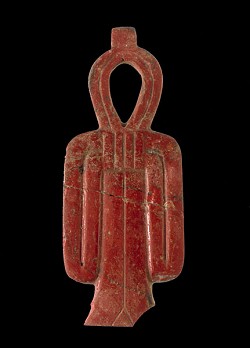
On the other hand, it might represent menstrual blood. Some say the amulet is shaped like the cloth worn by women during menstruation. Others have interpreted it as a representation of a ritual tampon that could be inserted in the vagina to prevent miscarriage. (Read more about that here. ) In addition to blood, the amulet’s red color could represent fire and the Sun—and the living, regenerative properties of Isis the Flame, the Radiant Solar Goddess and Lady of Rebirth.
In the later Hellenistic and Roman periods, the Knot of Isis becomes familiar as a knot tied into the clothing of the Goddess and Her priestesses and devotees.
The image to the right is a Roman-era Isis and shows the usual way we tend to see the Knot of Isis tied into clothing during the Greco-Roman period.
The Knot of Isis ensemble consisted of two pieces: an under-robe, long or short-sleeved, and an over-mantle that was draped around the body and tied together with a large knot—the Isis Knot—between the breasts. The mantle is often fringed. The mantle shown here has just a little fringe, which you can see a little bit where the ends of the knot hang loose.

In Egypt, however, the draped mantle was not quite the specialized mode of dress it became in the Greco-Roman world. In fact, scholars believe that the later Knot of Isis outfit derived from the type of Egyptian dress worn by many queens and noblewomen beginning in the New Kingdom (1570-1085 BCE). (Goddesses, on the other hand, are almost always shown wearing the old-fashioned sheath dress, the kalasiris, which is tight-fitting and held up by two wide straps that, sort of, cover the breasts.)
New Kingdom fashion became more sumptuous. Women’s clothing gained drapery and folds, but because it was often made of very sheer material, you could still appreciate the curves of the wearer’s body beneath. (Egyptian weavers were famed for their ability to create exquisitely fine linen. It was said that it was so fine that it could easily be pulled through a finger ring.)
The New Kingdom dress has material draped over both arms and knotted between the breasts. What we don’t see here is the heavy draping under the breasts that became characteristic of the Knot of Isis costume in later periods. Our beautiful New Kingdom lady has no need of an under-robe. Yet Isis’ Greek and Roman devotees, in their more modest—or perhaps, restrictive—cultures, preferred an undergarment of some kind, usually a simple robe like a Greek chiton.
As time passed and Egypt came under Greek and then Roman rule, Egyptian women would opt for an undergarment as well, either a slim, Egyptian kalasiris or a Greek chiton. There are some Egyptian images in which we can see the undergarment through the diaphanous draped mantle. In the Greek and Roman worlds, with the under-robe standard, the mantle could become shorter and more decorative. The fringe becomes more common and the draping, especially beneath the breasts, becomes more pronounced.

It appears to have been the Ptolemaic queens—who were often identified with Isis and Hathor/Aphrodite—who eventually turned the royal knotted outfit into an attribute of Isis specifically. The earliest known instance is Arsinoe II (born 316 BCE) on a monument known as the Pithom stele. There Arsinoe wears the knotted costume and Goddess headdress and is called “the image of Isis and Hathor.”
Arsinoe III is also shown wearing the knotted garment and headdress (see below) and she, too, is sometimes assimilated with Isis, for example, in inscriptions that blessed the queen as “Arsinoe Philadelphus Isis.”
By the time of Kleopatra III, Isis had gained more prominence and the queen became more and more associated with Her. When Kleopatra III gave birth to a son, she was hailed as “Isis, Mother of the God.” What’s more, because the child had the same birthday as the Apis bull, Kleopatra III also became the “Isis cow,” the Mother of Apis. It is more than likely that Kleopatra III encouraged these types of identifications as she was in an intense rivalry with her mother, Kleopatra II, to whom Ptolemy VIII was still married when he also married his niece, Kleopatra III. Talk about complicated relationships. Ptolemies. Sheesh.

It is, as yet, unknown exactly when Isis Herself was first represented wearing the characteristic knot. What seems likely is that, as the Isis-identified queens were more and more often shown wearing the knotted garment, artists naturally took up that same style when creating images of the Goddess Herself. Queens have always been fashion setters.
Priestesses and devotees of the Goddess might then choose to imitate the dress of Isis as they saw it being depicted in the art and temples around them.

To recap: the knotted garment was originally an Egyptian fashion, especially seen on royal and noble women. The Ptolemaic queens, who were Greek but trying to be more Egyptian, adopted the knotted garment as an outfit that Egyptian royals wore. As part of “becoming Egyptian” the Ptolemies promoted the cult of Isis, Osiris/Sarapis, and Horus/Harpokarates. Egyptian tradition already associated the pharaoh with Horus, the son of Isis. To emphasize their Egyptian-ness, the Ptolemaic queens began to associate themselves with Isis and with Hathor. By the end of the dynasty, Isis was the more prominent Goddess and the queens, wearing their Egyptian knotted outfits, were strongly identified with Isis.
What’s more, since there was already a famous knot associated with Isis, the tyet, it was easy to connect the knotted garment with the Goddess of the sacred knot, the Knot of Isis.
At the time when the Ptolemaic queens were identifying themselves with Isis, the Goddess’ worship was being widely disseminated outside of Egypt. Non-Egyptian artists looked to Egypt for the way to portray the Goddess. Naturally, they looked to the queens. They then used the knotted garment, along with other Egyptian symbols, such as the lotus and the crocodile, to indicate that the sacred image they were creating was indeed intended to be Isis Herself.

So that’s the connection between the ancient amulet known as the Knot of Isis and the characteristic knotted garment of the Goddess in the Greco-Roman period. Yet we do well to remember that the Knot of Isis, first and foremost, has to do with Isis’ power as Goddess of Magic; Isis works heka with knots. For those of us who worship Her today, we may see the Isis Knot not only as a visual emblem indicating the Goddess, but also as a symbol of Her magical power to surround, unite, and protect.


